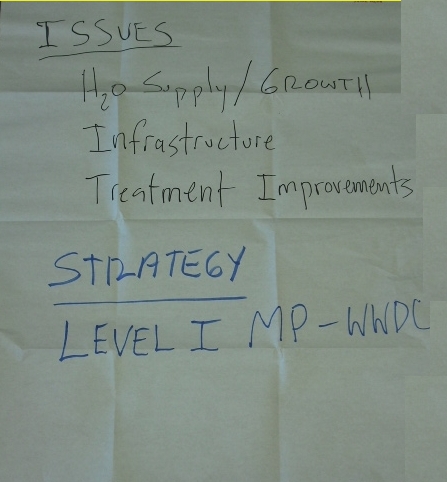Wyoming State Water Plan
Wyoming State Water Plan
Wyoming Water Development Office
6920 Yellowtail Rd
Cheyenne, WY 82002
Phone: 307-777-7626

Wyoming Water Development Office
6920 Yellowtail Rd
Cheyenne, WY 82002
Phone: 307-777-7626



The meeting generally followed the format of the agenda distributed by the WWDO:
1. Introductions
Earl Degroot, Facilitator on the Planning Team, introduced the team and presented several logistical details about the meeting.
2. Description and purpose of meeting
Earl presented a power point slideshow outlining the purpose of the planning process, explaining the handouts at the meeting, and the methods through which the State and Planning Team was collecting input. That presentation is available at waterplan.state.wy.us
Murray Schroeder presented information and exhibits' showing the progress the consulting team has made making population projections in the basin. That information is available at waterplan.state.wy.us.
Information he presented included a couple of figures showing population projections and several figures presenting the forecasted water needs for the municipal, industrial and domestic water use sectors.
4. Presentations
An important goal of the BAG Update process is to advance the BAG's identification and discussion regarding strategies for resolving basin water use issues. The previous 2001 plan identified many issues, but did not address in depth how those issues might be resolved. With a goal of identifying strategies, this and future BAG meetings are designed to have public presentations from a variety of BAG members. The presentations are intended to present the BAG member's ideas about what their specific challenges are and what some of the strategies might be for addressing the challenges. By design, this public meeting setting is intended to foster an open discussion about strategies.
To this end, this meeting had two presentations, each followed by a strategies discussion in which ideas were recorded by the planning team. Those ideas were recorded on large paper flip charts (photos attached).
Presentations were as follows:
A. Kememrer/Diamondville Joint Powers Board, Mary Crosby presented information on the challenges that the community is facing, including the following items:
Mary presented the fact that the Joint Powers Board has applied to the WWDC for a Master Plan, which was the primary strategy they had in mind for addressing most of the above issues. The study is just now getting started.
B. Mike Purcell, Director, Water Development Commission, presented on the general subjects of water planning and reservoir storage as a strategy for resolving some water supply issues. An outline of the material he presented follows:
Master Plans need to focus on identifying rates structures that can pay for the operation of the water utilities.
WWDC has changed operating criteria recently, and now they will potentially pick up a greater share of the costs of reservoir projects, in contrast to older criteria that specified maximum amounts at which WWDC would participate.
The WWDC is now looking for storage partners. The WWDC is very much interested in discussing partnerships with folks that want projects to help themselves.
Mike stated that reservoir storage will only sell if the project has identified uses. Reservoirs can not be speculative.
The USBR and WWDC are working on a MOA to define administration of carry over water from year to year in Fontenell. Of the 120,000 act feet of storage, only 46,000 ac-feet have been sold.
Buffalo Bill reservoir is a case of a reservoir where all of the water in the reservoir can not be used most of the time and that others, including recreational interests, have come to rely on the benefits of the reservoir. This tends to create problems when the WWDC wants to sell some water.
Lake Desmit is another reservoir, whose uses are becoming controlled by interests that were not involved in the original intent of the project.
The number one benefit of the basin planning process is to provide a network of folks to work on issues and strategies for resolving issues.
Mike offered several thoughts on the current state of affairs with this local reservoir, owned by PacifiCorp.
Finally, Mike commented on the preference of the WWDC to do business with Irrigation Districts as opposed to Conservancy Districts. The advantages of an irrigation district are that there are legal boundaries and loan collateral.
C. General Audience Participation
In addition to listening to the issues and strategies presentations from above, the meeting included a broader discussion of the issues and strategies in the basin and these included:
The strategies identified that might help included:
A strategy that was identified was to evaluate reservoir release options (i.e. releasing from different reservoir elevations) to improve stream water quality
Strategies included water recycling, treatment of poor quality water, and promoting policy that allows these resources to be used.
Public awareness was identified as a large strategy for addressing the issue. Tool kits were given as an example of outreach that could be used to educate.
The strategies identified by the audience included using WWDC planning process to the degree possible to evaluate funding alternatives.
D. Steve Wolff, SEO; Update on Colorado River Basin Topics
Steve was present and spoke briefly to the group regarding the status of the studies he was managing in the basin, although he did not have much to report.



